DISCLAIMER
the content of these galleries is a private property
neither the text nor the pictures may be republished, nor used for any purpose, without the author's permission
~ NOTE ~
The reprint of the Hofämterspiel shown in this page is by Piatnik (Austria).
Notes in square brackets along the text refer to the booklet which accompanies the
edition, written by a team of scholars:
[1] Fritz Koreny
[2] Georg Kugler |
[3] Michael Dummett
[4] Detleff Hoffmann |
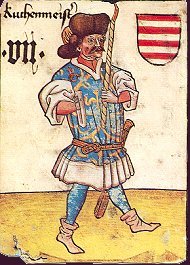
VII of Hungary (chief cook) |
THE HOFÄMTERSPIEL
The Hofämterspiel is a late mediaeval deck containing 48 cards, all of which
have survived.
Together with other playing cards, it belonged to the great collection of
art treasures gathered in the 16th century by archduke Ferdinand of Tirol, and it is
mentioned in the collection's catalogue [1], the
only known record of the deck.
These large cards measure 97 mm x 140 mm (3¾ in x 5½ in);
they feature wood engravings skilfully decorated with vivid colours, and a few additions in
finely embossed silver and gold leaf.
It is impossible to assess the precise age of the deck, though around the mid 15th century
appears to be a quite reasonable dating. It is also very likely that the geographic area where
the cards were made was southern Germany, i.e. today's Austria [1].
|
THE SUBJECTS
Unlike other known decks of the same age belonging to German culture, such as the
Hofjagdspiel, whose illustrations featured hunting scenes, and whose suits were
falcons, ducks, deers, etc., the Hofämterspiel was basically inspired
by the standard social structure of royal courts during the late Middle Age. The illustrations
picture the many different members of a typical household [2],
with their names in archaic German, whence the name Hofämterspiel given to the
cards (literally meaning "householder's deck").
Therefore, what makes these cards particularly interesting is not only their intrinsic value
for the early history of playing cards, but also the direct evidence they provide for the
knowledge of social hierarchy and everyday's
life in late mediaeval courts. |

IX of France (marshal) |
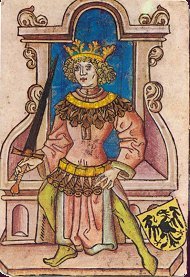
king of Germany |
On the basis of written sources which describe no longer existing decks, it has also been
suggested that the concept of playing cards whose values were inspired by social levels probably already existed in the late 14th century: this would mean that the "household"
system might have been an earlier creation than the "hunting" system [1],
thus representing the very first variety of local deck in the German world. |

queen of Bohemia |
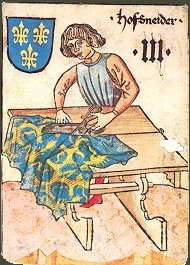
III of France (tailor) |
THE SUIT SYSTEM
Another important difference with the above-mentioned "hunting" decks is the choice of suits: in the
Hofämterspiel they are represented by four different shields. The emblems
are those of Germany (a black eagle on yellow background),
France (golden fleur-de-lys on blue background), Bohemia
(a white rampant lion on red background) and Hungary (white and red
horizontal stripes): by the 15th century, these were the four main countries in central Europe.
Therefore, the author's intention was probably to celebrate with this
deck a local monarch or ruler, eventually Ladislas Postumus, king of Hungary and Bohemia from
1453 to 1457, according to a theory by Arpad Weixlgärtner [1].
Obviously, the choice of suit symbols in the Hofämterspiel provides an interesting analogy with the
Shields suit of Swiss playing cards, still in use today (see also the Swiss gallery).
|
THE 48 CHARACTERS AND THEIR RANKS
Each of the Hofämterspiel's cards features a different character, almost as a
pack made of 48 courts. In each suit, the values rank from I (the lowest) to
X, and they end with a queen and a king (the highest card). The king and queen do not
feature a number, and are also the only two cards not stating the character's occupation,
so that they might be considered the actual court cards of the deck.
In all four suits, the I shows a fool (Narr, or its female
equivalent Narryn), while the two highest cards next to the
king and queen are the master of the household or major domo
(Hofmeister, X, who was in charge of the court during
the ruler's absence), and the marshal (Marschalk, IX,
in charge of any duty that involved the use of horses or carriages, such as the king's travels,
etc.).

X of Germany (household master) |
With the exception of two subjects (the Jungfrawe,
lady-in-waiting, card VI in all suits, and the Trometer,
trumpeter, card IIII in Germany and Hungary), all other characters are individual,
changing from suit to suit.
The social rank of each of them may be easily understood,
according to the higher or lower value the relevant card is worth in the deck. Therefore,
for instance, a doctor (Artzt, Bohemia suit) would have
occupied more or less the same social level of a chaplain (Capplan,
Germany suit), or of a chancellor (Kanzler, Hungary suit),
or of a household mistress of a queen or a princess (Hofmeistryn,
France suit), so all these subjects appear on cards VIII belonging to different suits.
A full list of the characters and their values is shown in the following table: for an easier reference,
subjects not appearing in all four suits are shown in pale green.
|
TABLE OF THE HOFÄMSTERSPIEL'S CHARACTERS
| value suit |
|
 BOHEMIA BOHEMIA
|
 FRANCE FRANCE
|
 GERMANY GERMANY
|
 HUNGARY HUNGARY
|
...
...
X
IX
VIII
VII
VI
V
IIII
III
II
I
|
|
König
king
Königin
queen
Hofmeister
household master
Marschalk
marshal
Artzt
doctor
Kammer[mei]ster
chamberlain
Junckfrawe
lady-in-waiting
Valkner
falconer
Trometer
trumpeter
Herolt
herald
Hefneryn
potter (female)
Narr
fool
|
König
king
Königin
queen
Hofmeister
household master
Marschalk
marshal
Hofmeistryn
household mistress
Schenk
cup-bearer
Junckfrawe
lady-in-waiting
Koch
cook
Marstaler
master of the stables
Hofsneider
tailor
Jeger
huntsman
Nerryn
fool (female)
|
König
king
Königin
queen
Hofmeister
household master
Marschalk
marshal
Capplan
chaplain
Truchses
steward
Junckfraw
lady-in-waiting
Kellner
wine-cellar man
Parbirer
barber
Renner
jouster
Bott
messenger
Narr
fool
|
König
king
Königin
queen
Hofmeister
household master
Marschalk
marshal
Kantzler
chancellor
Kuchenmeist[er]
chief cook
Junckfrawe
lady-in-waiting
Schutz
archer
Trometer
trumpeter
Vischner
fish-monger
Pfister
baker
N[er]ryn
fool (female)
|
Ranking by social hierarchy
appears similar to that of
Mantegna's Tarot's
first group of cards.
Among the list of subjects, the lowest cards of the series seem to have elements in
common with other obsolete decks, though not as old as the
Hofämterspiel.
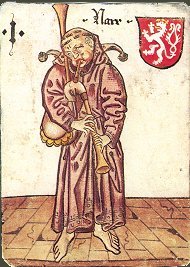
I of Bohemia (male fool) |
The Bavarian-Austrian Hexenspiel, belonging to the so-called group of Cuckoo decks
(see Cards Without Traditional Suits, page 2), had a card named Narr which featured a fool
(although the same subject in German and Austrian tarot decks is called Sküs,
after the French l'Excuse, and looks like a joker).
In some respects, the four Narr and Narryn also link to the knaves of
the Minchiate deck, which featured two male
and two female characters; also German decks from the 16th century, such as the
Ulmer Spiel and the Stuttgarter Spiel,
had two male knaves and two female ones [4]. |
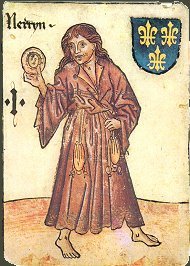
I of France (female fool)
|
Which game or games the Hofämterspiel was specifically created for is virtually
impossible to tell, since no other source except Ferdinand of Tirol's catalogue entry
specifically mentions the deck or it's use. Due to the very fine quality of the cards,
and because of the particular structure of the ranks (six matching subjects in all four
suits, and six mismatching ones, with a fool as last card of the suit), it
appears likely that the Hofämterspiel was used for playing a trick-taking game,
in which the Narr and Narryn might have acted as jokers [3].
However, it is interesting how several female characters too were part of the
card game, as well as of daily life at court, at many different hierarchic levels: queen,
mistress of the household (VIII), lady-in-waiting (VI), potter (II),
fool (I).
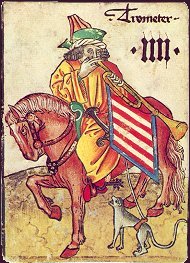
IIII of Hungary (trumpeter) |
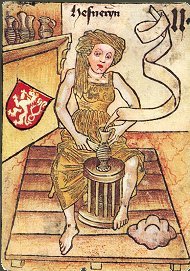
II of Bohemia (female potter) |
OTHER GALLERIES




















or back to

INTRODUCTION
AND HISTORY
|

MULTI-LANGUAGE
GLOSSARY |

THE FOOL &
THE JOKER |

INDEX
TABLE |

REGIONAL
GAMES |

PLAYING CARD
LINKS |